Welcoming a new kitten into your home is a joyous occasion, filled with laughter and endless cuddles. Teaching your kitten to use the litter box is a crucial task. With patience and the right approach, you can ensure a clean and happy home for both of you.
Litter box training for kittens may seem daunting, but it’s manageable. Understanding your kitten’s natural instincts and learning how to train your kitten to use a litter box can make the process stress-free. This article will guide you through easy steps, share tips for choosing the best litter box, and offer advice on common issues. Every kitten is unique and may learn at their own pace. Some may pick it up quickly, while others need more guidance. The key is to stay patient, positive, and consistent. With the right tools and techniques, your kitten will become a pro at using the litter box in no time!
Let’s explore the world of litter box training for kittens together. By the end of this article, you’ll be confident and prepared to tackle this important milestone. Get ready to create a loving environment that supports your kitten’s health, happiness, and lifelong bond with you.
Understanding Your Kitten’s Natural Instincts
Understanding your kitten’s natural instincts is crucial for litter box training. Kittens are born with a strong instinct to eliminate in sandy, granular places. This instinct helps them maintain cleanliness and hygiene in their natural environment.
In the early weeks, mother cats play a vital role in teaching kittens to eliminate. They stimulate their kittens to go potty and clean them afterward. This maternal care is essential for kittens to develop healthy elimination habits and learn to associate certain textures with bathroom activities.
Kittens Naturally Seek Out Sandy, Granular Places to Eliminate
When you bring your kitten home, they will instinctively seek out sandy, granular places to eliminate. Providing a litter box filled with soft, fine-grained litter is essential. For kittens under 3-4 months, avoid clumping litter to prevent ingestion and potential health issues.
Mother Cats Stimulate and Clean Their Kittens in the First Few Weeks
Very young kittens may need manual stimulation for elimination until they can use the litter box consistently. You can mimic a mother cat’s care by gently rubbing your kitten’s genital area with a warm, damp cloth. As your kitten grows and becomes more independent, they will naturally transition to using the litter box on their own.
By understanding your kitten’s natural instincts and providing a safe, accessible litter box, you’ll be well on your way to successful litter box training. Remember, patience, love, and consistency are key when learning how to train your kitten to use a litter box.
When to Start Litter Training Kittens
As a new kitten owner, you might wonder when to start litter training. The good news is that kittens naturally seek out a sandy, granular place to eliminate. This makes litter box training easier than you might think. Kittens usually start using the litter box around 3 weeks old. This is when they begin weaning from their mother and start eating solid food. By 8 to 12 weeks, they are ready to use a litter box on their own.
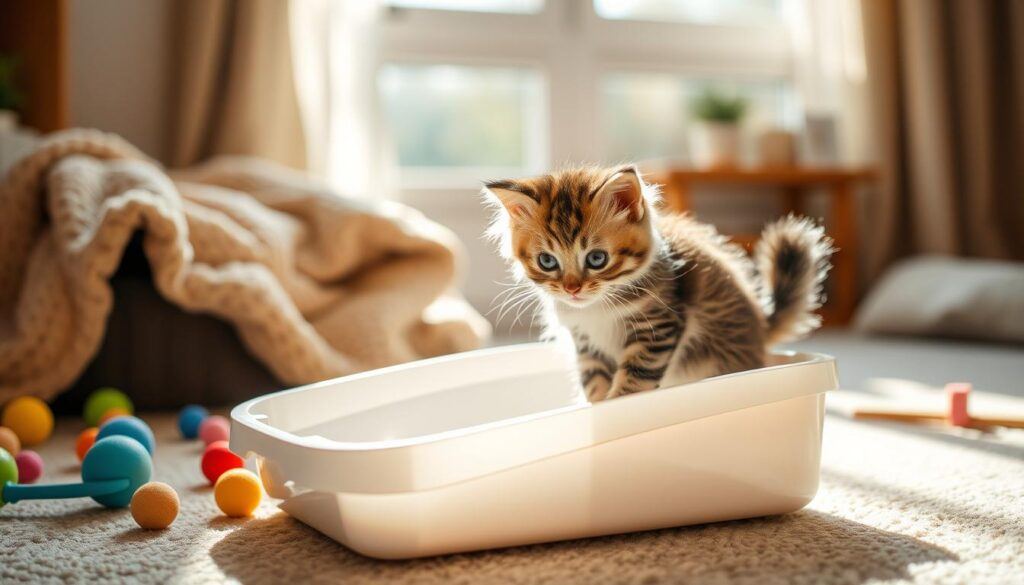
Begin Litter Training at Around 4 Weeks of Age
While kittens may show interest in the litter box at 3 weeks, start training at 4 weeks. At this age, kittens can learn and retain new habits better. For kittens under 8 weeks, a shallow cardboard tray can be a temporary litter box until they grow.
Older Kittens and Adult Cats Can Start Training Immediately
If you’ve adopted an older kitten or adult cat, they can start training right away. Provide a litter box that’s 1.5 times the cat’s length and fill it with fine-grain litter. Place it in a well-lit, accessible area. Encourage your cat to use it by gently placing them inside after meals or naps.
Remember, patience and positive reinforcement are crucial when training kittens or cats. With consistency and the right supplies, your feline friend will learn to use the litter box. This will make your home happy and stress-free for everyone.
Choosing the Right Supplies for Litter Box Training
Starting your kitten’s litter box training journey requires the right tools. You’ll need litter boxes that fit your kitten’s size, non-clumping litter, and a litter scoop. These essentials make the process smoother for both you and your kitten.
When picking a litter box, think about your kitten’s size and what they like. A study in 2012 found cats don’t have a clear preference for covered or uncovered litter boxes. Try both to see what your kitten prefers. Also, 88% of kittens like litter boxes with shorter walls, making them more comfortable and accessible.
Start with non-clumping litter for the early stages of training. It’s safer for kittens who might eat it. Choose unscented litter to avoid irritation. Gradually introduce new litters to prevent your kitten from developing a dislike for the litter box.
In homes with multiple cats, have one litter box per cat plus an extra. This prevents territorial behavior and dominance issues. Keeping the litter box clean is key. Daily waste removal and weekly deep cleans keep your kitten happy and encourage good litter box habits. Choosing the right supplies for litter box training kittens sets the stage for a comfortable environment. This encourages your kitten to develop good habits from the start.
Selecting the Perfect Litter Box for Your Kitten
Choosing the right litter box for your kitten involves several key considerations. Finding the best litter box for kittens means selecting one that suits their size and deciding whether a covered or uncovered option will better support their comfort and encourage regular use.
Size Matters: Choose a Litter Box Appropriate for Your Kitten’s Size
Kittens grow rapidly, making it crucial to pick a litter box that fits their current size and allows for future growth. When you housetrain a kitten, the box should be at least one and a half times your kitten’s length. This ensures they have enough room to turn and dig comfortably. Young kittens need a box with low sides for easy access. As they grow, you can switch to a larger box with higher sides.

Uncovered vs. Covered Litter Boxes: Pros and Cons
Deciding between an uncovered or covered litter box depends on your kitten’s preferences and the benefits of each. Uncovered boxes offer easy access and allow kittens to see their surroundings, enhancing their sense of security. Covered boxes, in contrast, provide privacy and help control odors and scattered litter. Yet, some kittens might find covered boxes confining or uncomfortable. It’s vital to watch your kitten’s behavior and adjust your choice based on their needs.
The ideal litter box for your kitten will align with their unique needs and preferences. By selecting the right size and considering uncovered or covered options, you’ll support their litter training journey effectively.
How to Train Your Kitten to Use a Litter Box
Teaching your kitten to use a litter box is a vital part of their growth. Most owners can achieve this in about four weeks. It’s important to understand their natural instincts and provide a suitable environment. Incorporating these tips for litter box training kittens can help ensure the process goes smoothly and encourages them to develop proper litter box habits.
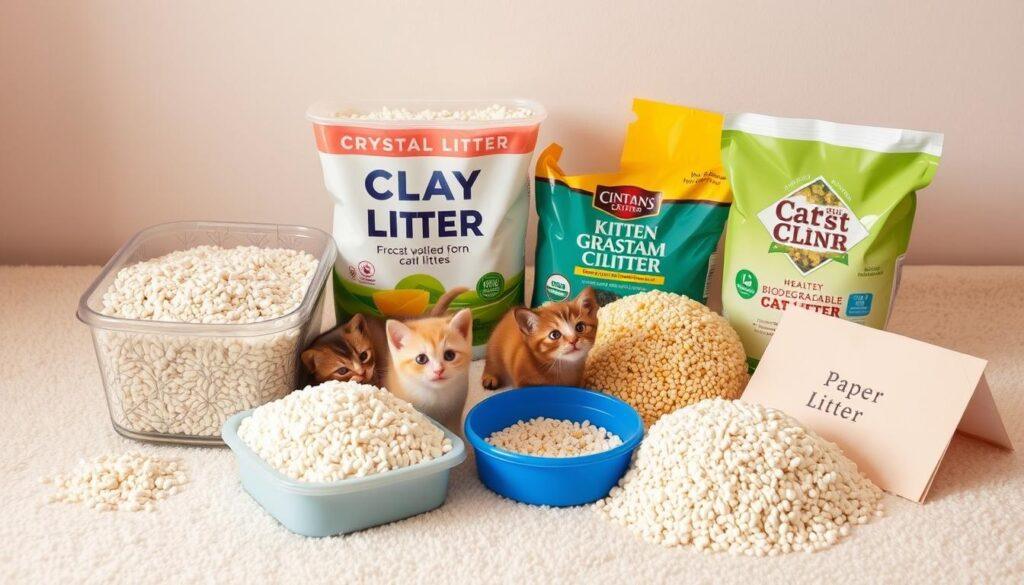
Pick the Right Type of Litter for Your Kitten
Choosing the right litter is crucial for successful training. Use coarse-grained, non-clumping litter to prevent ingestion. Kittens are naturally curious and playful. Experts recommend switching to fine-grain litters as they grow older, as most cats prefer them.
Place Litter Boxes in Accessible, Well-Lit Areas
Ensure litter boxes are easy to access and in well-lit areas. It’s wise to have more litter boxes than cats, with extra for kittens. This is because their playful nature may delay bathroom needs. Place a litter box on every floor for convenience.
Introduce Your Kitten to the Litter Box
Introduce your kitten to the litter box gently. Allow them to explore and get familiar. Kittens under three weeks old need their mother’s guidance for toilet training. Litter training should start around 4 weeks of age, when they begin weaning.
Reward Good Litter Box Habits
Positive reinforcement is key in litter training. Reward your kitten with treats and praise for correct use. Consistency and patience are essential for success. Scoop the litter box after each use and clean it weekly for a clean environment.
Maintaining a Clean Litter Box Environment
Keeping your kitten’s litter box clean is crucial for their consistent use and to prevent accidents. Most kittens learn to use the litter box between 8 to 12 weeks old. If your 12-week-old kitten won’t use their litter box, it’s wise to consult your vet. This ensures there are no medical or behavioral issues at play.
To keep the litter box clean for kittens, remove waste daily and do a deep clean weekly. This not only prevents accidents but also makes training more enjoyable for your kitten. Regular cleaning is key for successful litter training and establishing consistent bathroom habits.
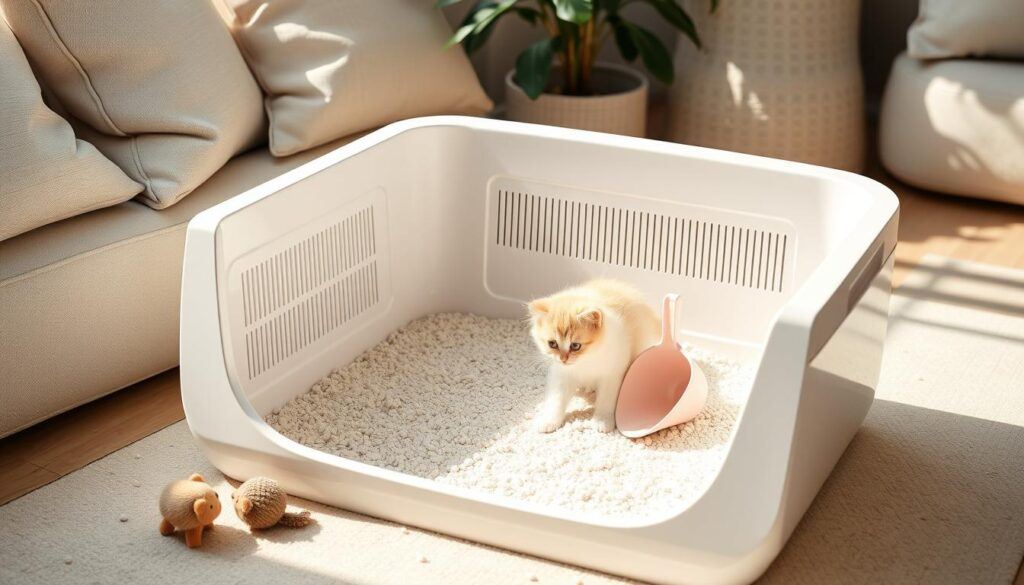
Make sure you have enough litter boxes for all cats in your home and place them in easy-to-reach spots. The right litter type, such as non-clumping, unscented, and dust-free, can significantly influence your kitten’s adaptation to the litter box.
A clean litter box environment is vital for hygiene, even more so in homes with other pets and children. Not properly training your kitten can lead to litter box avoidance and inappropriate elimination. This causes frustration for owners and discomfort for the cat. If your kitten still refuses to use the litter box, despite your efforts, it’s time to seek veterinary advice to uncover any underlying issues.
Troubleshooting Common Litter Box Issues
Even with the best care, your kitten might face litter box problems. Patience and troubleshooting can help your furry friend recover. Research shows at least 10% of cats develop elimination issues at some point.
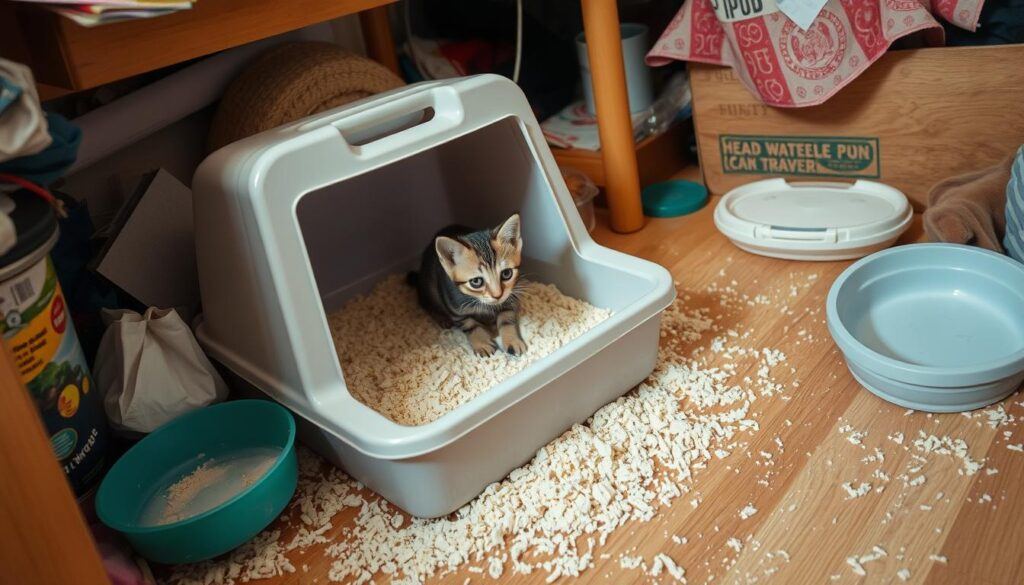
Several reasons can cause litter box issues. These include litter-box management, surface and litter preferences, location, and medical problems. Medical issues like urinary tract infections and kidney stones are common causes.
Reevaluate Your Litter Box Setup
Ensure you have one litter box per cat, plus an extra for multiple cats. Place litter boxes in quiet spots, away from foot traffic. Keep them away from dogs and kids to reduce stress. In multi-story homes, have a litter box on every floor for easy access.
Consider Changing the Litter Box or Type of Litter
Cats may dislike changes in litter smell or feel. Try different litter types to find what your cat prefers. Use shallow litter boxes for easier access, ideal for small kittens and older cats. Bigger or uncovered litter boxes in areas with escape routes can also help.
Increase Frequency of Scooping and Replacing Litter
Scoop the litter box at least twice a day. Clean, disinfect, and replace all litter weekly. A clean litter box is key to prevent cats from eliminating outside. Use enzyme cleansers for accidents outside the box.
Use Pheromone Diffusers to Relieve Stress
Stress from events like moving can lead to litter-box issues. Pheromone sprays like Feliway® and Rescue Remedy® can help. Special treats like Composure Soft Chews also reduce stress and encourage positive litter box experiences. Behavioral treatments tailored to your cat’s problem can be effective. If issues persist, consult your veterinarian to check for medical concerns.
The Importance of Patience and Consistency in Litter Box Training
Patience and consistency are paramount in litter training your kitten. Kittens naturally want to dig and cover their waste. They need guidance to learn the right place and method. A consistent schedule for feeding, play, and bathroom breaks helps predict when they need to use the litter box.
Kittens may have accidents as they learn. It’s crucial to stay calm and reinforce good habits. Positive reinforcement, praise, and treats help reinforce good litter box behavior. Regular litter box cleaning is also vital, with daily scooping and weekly changes to keep your kitten using it.
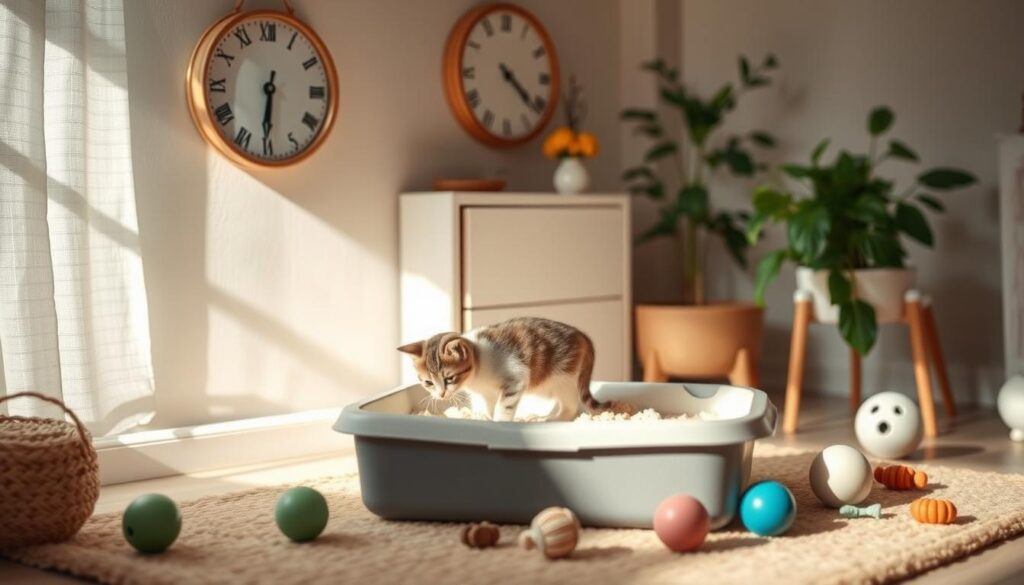
Not properly training a kitten can lead to behavioral issues. These include litter box avoidance and inappropriate elimination. If your kitten is trained but still has accidents, close supervision or confinement may be needed. Environmental stress can also cause these accidents, so it’s important to protect sensitive cats from stressors.
Consistency is key in litter box training. Ensure a clean litter box, offer gentle encouragement, and reward correct use. With time and patience, your kitten will learn this essential skill. Remember, the rule of thumb is one litter box per cat, plus one extra. So, for one cat, you should have two litter boxes.
Preventing Future Litter Box Problems
Congratulations on successfully training your kitten to use the litter box! Your work is far from over, though. To keep your feline friend using the litter box consistently, it’s vital to maintain good habits and prevent future issues.
Keeping the litter box clean is key to preventing litter box issues in cats. Cats are naturally clean and may avoid a dirty litter box. Scoop the litter box at least twice a day and wash it weekly with mild soap. Using enzymatic cleaning products for pet waste can help eliminate odors effectively.
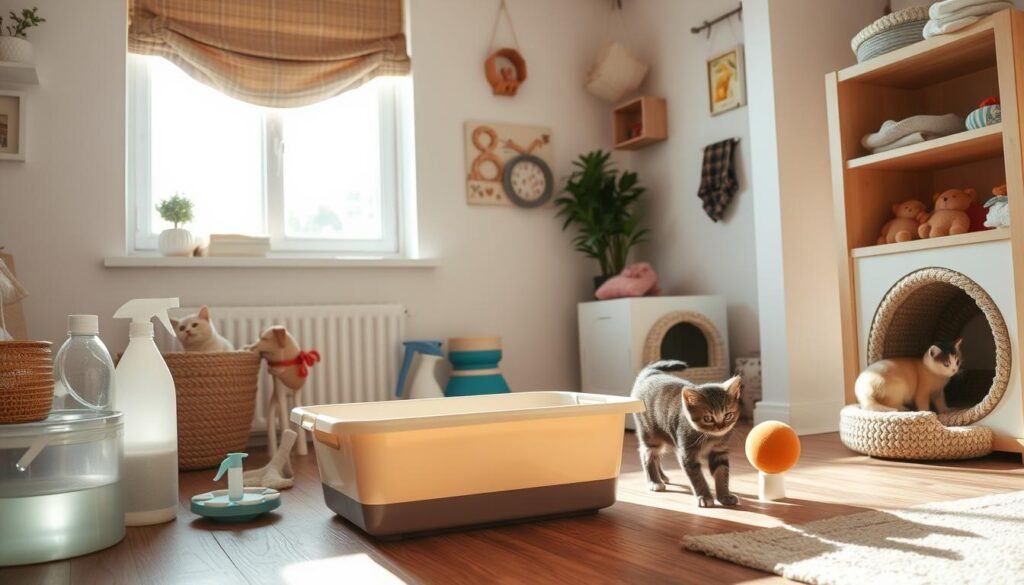
If you have multiple cats, ensure you have enough litter boxes. The rule of thumb is to have one litter box per cat, plus an extra. This guarantees each cat has a clean, accessible spot to eliminate, reducing litter box avoidance.
Changing the litter type or litter box location should be done gradually. Sudden changes can stress and confuse your cat. Also, provide your cat with plenty of exercise and enrichment to keep them mentally stimulated and reduce stress, which can lead to litter box issues.
Preventing litter box problems is an ongoing effort that requires patience, consistency, and attention to detail. By staying proactive and maintaining a clean, inviting litter box environment, you can ensure your cat uses the litter box consistently. This leads to a happier, healthier life for both of you.
Litter Box Training Success Stories: Real-Life Examples
Learning from others can greatly help in litter box training your kitten. These stories show patience, consistency, and positive reinforcement are key. They help kittens learn this crucial skill.
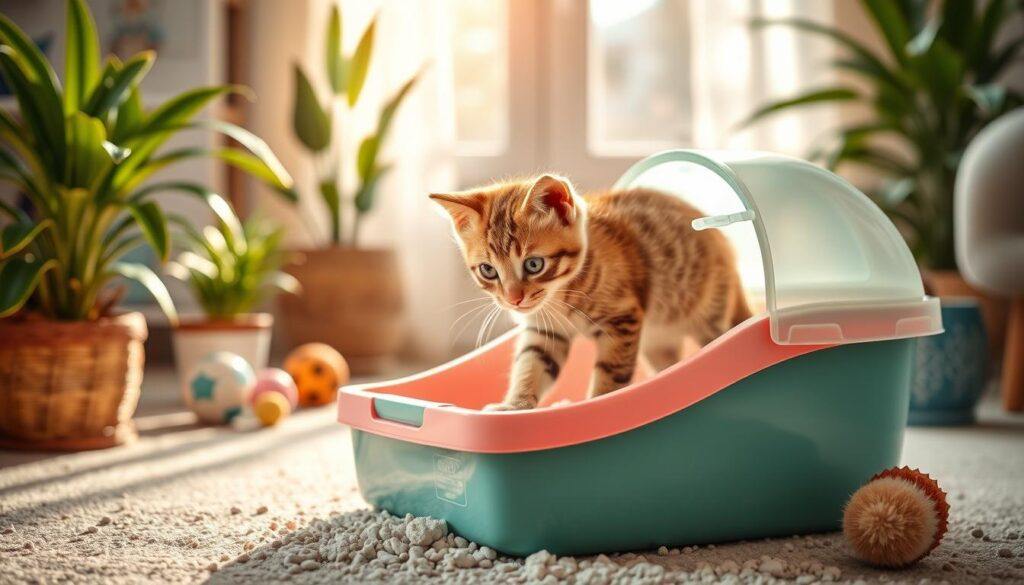
From Shelter to Forever Home: A Kitten’s Litter Box Journey
The Johnson family adopted Luna from a local shelter. They knew they had to start litter box training immediately. They provided Luna with a quiet, well-lit spot for her litter box. Consistently praising and treating her for using it, they trained her in just a few weeks.
Luna’s move from shelter to forever home was smooth. This was thanks to her family’s commitment to positive reinforcement training.
Overcoming Challenges: How One Family Trained Their Kitten
The Wilsons faced a unique challenge with Max. Max was hesitant to enter the litter box and would often go just outside. They placed the litter box in a more accessible area that Max preferred. Using a clicker to reinforce positive behavior, they successfully trained Max.
Their story emphasizes the need to understand your kitten’s needs. Adapting your training approach to their preferences is crucial. These real-life examples of kitten training prove a well-planned training regimen works. By creating a safe, comfortable environment and using positive reinforcement, you can achieve litter box training success. This will also strengthen your bond with your new feline friend.
Recommended Products for Litter Box Training Success
Choosing the right products is crucial for litter training your kitten. With numerous options, selecting the best can be daunting. The Purina Tidy Cats Litter Box System stands out as a convenient and effective solution for your kitten’s training.

The Purina Tidy Cats Litter Box System is tailored to your kitten’s needs. It has a low entry point, making it simple for your kitten to enter and exit. The system includes small granule litter, encouraging your kitten to bury their waste naturally. High walls also prevent litter scatter and contain accidents.
When selecting litter training products, consider the litter box size. Commercial boxes are often too small for cats. The Purina Tidy Cats Litter Box System offers ample space, ensuring your kitten’s comfort.
Purina Tidy Cats Litter Box System: The Perfect Solution for Kitten Training
The Purina Tidy Cats Litter Box System is a revolutionary solution designed with both pet owners and their kittens in mind. It’s crafted for ease of use, efficient cleaning, and enhanced odor control, making it an excellent choice for busy households.
Key Features and Benefits:
Three-Layer Design for Simplified Maintenance
The system features an innovative three-layer design:
- Absorbent Pads: The bottom layer contains super-absorbent pads that trap moisture and lock away odors for up to a week.
- Pellet Layer: Specially designed pellets sit on top and allow liquids to pass through while keeping solid waste on the surface for easy scooping.
- Removable Tray: The tray makes it simple to replace litter and pads without creating a mess, ensuring a clean and fresh environment for your kitten.
Easy Daily Cleaning
Daily maintenance is quick and hassle-free. The pellets’ non-clumping formula allows solid waste to be scooped out easily, minimizing odors and keeping the area sanitary for your kitten. This reduces the need for frequent full litter replacements.
Effortless Weekly and Monthly Cleaning
The removable tray makes weekly litter pad replacements simple, saving time and reducing mess. For a deeper clean, the durable materials make it easy to rinse and sanitize the entire system monthly, ensuring long-term freshness and usability.
Odor Control for Multiple Pets
This system is particularly effective at controlling odors, making it a great choice for households with multiple cats. The absorbent pads and pellets work together to neutralize smells, keeping your home fresh.
Durability and Design
Built with high-quality materials, the Purina Tidy Cats Litter Box System is designed to last. Its sleek and practical design ensures it fits well in most spaces while being easy to handle and clean.
Encourages Litter Training Success
The system’s thoughtful design makes it easier for kittens to adapt to litter training, thanks to its consistent cleanliness and minimal odors. By providing a clean and comfortable space, you can help your kitten feel more confident during the training process.
Why Choose Purina Tidy Cats Litter Box System?
Investing in this litter box system simplifies the litter training process, allowing you to focus more on building a bond with your kitten. Combined with consistency and patience, having the right tools like this system can make all the difference in ensuring litter training success.
By choosing the Purina Tidy Cats Litter Box System, you’re not only investing in convenience but also creating a more hygienic and stress-free experience for both you and your furry friend.


Conclusion
Learning to train your kitten to use a litter box is essential when bringing a new pet home. Understanding your kitten’s instincts and providing the right supplies makes the process easier. Choose a litter box that’s at least 1.5 times your kitten’s length. Use 2 to 3 inches of fine, unscented clumping litter for comfort and odor control.
Consistency and patience are crucial in litter box training. Place the litter box in a spot that’s easy to reach and well-lit. Introduce your kitten to it gently. Reward good behavior with treats, praise, and playtime. Keep the litter box clean by scooping daily and deep cleaning weekly. Aim for one litter box per kitten, plus an extra for households with more than one kitten.
If your kitten has litter box issues, like eliminating outside or showing odd behaviors, don’t punish them. Review your litter box setup and consider changing the litter or cleaning frequency. If problems continue, consult your vet to check for health issues. With the right approach and patience, you can train your kitten successfully, creating a happy home environment.
Frequently Asked Questions
Q: When should I start litter box training my kitten?
A: Litter training should begin when kittens are around 4 weeks old. This is when they naturally start to wean from their mother and become more independent. At this age, kittens are primed to learn new habits, making it an ideal time to introduce them to a litter box. This early introduction helps set the stage for proper behavior. For kittens or adult cats adopted later, training can start right away. The essential step is to ensure the litter box is clean and easily accessible. Place it in a quiet spot. Positive reinforcement is key to encourage the cat to use it correctly, regardless of their age.
Q: What supplies do I need for litter box training my kitten?
A: To ensure your kitten’s litter box training success, you’ll need a few essential supplies:
- Litter Box: Choose a litter box that’s the right size for your kitten. A shallow box is ideal for easy access, while a larger box can be used as they grow.
- Litter: Opt for a non-clumping litter initially, as it’s safer for kittens who may accidentally ingest it while exploring. Look for litter that is low-dust and designed for kittens.
- Litter Scoop: A sturdy scoop makes cleaning quick and efficient, helping to maintain a clean and inviting litter box.
- Litter Mat: Place a mat around the litter box to catch any stray litter and keep your floors clean.
- Cleaning Supplies: Have an enzymatic cleaner on hand to deal with accidents and eliminate odors outside the litter box, discouraging repeat incidents.
Having these supplies ready will not only make training easier for your kitten but also create a stress-free experience for you. A clean, accessible, and properly maintained litter area sets your kitten up for long-term success.
Q: How do I choose the right litter box for my kitten?
A: When selecting a litter box for your kitten, it’s essential to consider their current size. Ensure the box is low enough for them to climb in and out with ease. You must also decide between an uncovered or covered box, based on your kitten’s comfort and habits. Uncovered boxes are accessible and may help kittens feel less intimidated, which is beneficial during training. On the other hand, covered boxes provide privacy and help contain odors. Yet, they might make some kittens feel confined or reluctant to use them. Material and design are also critical factors. Lightweight plastic boxes are easy to clean. Some models feature high sides or litter mats to minimize mess. Remember, kittens grow rapidly, so you may need to upgrade to a larger box as they mature.
Q: How often should I clean my kitten’s litter box?
A: Keeping your kitten’s litter box clean is essential for their consistent use. Daily scooping removes waste and controls odors. A weekly deep clean is also necessary, involving emptying the litter, scrubbing the box with mild soap and warm water, and refilling it with fresh litter. In households with multiple cats or where odors build up fast, more frequent cleaning is required. A clean litter box prevents accidents and makes your kitten feel comfortable. It also encourages them to use the litter box correctly.
Q: What should I do if my kitten is having trouble using the litter box?
A: If your kitten has trouble with the litter box, first check your setup. Make sure the box is easy to get to and in a quiet spot. This area should be low-traffic and make your kitten feel safe. You might need to change the litter type or use a shallower box for easier entry and exit. Also, scoop and replace litter more often to keep the box clean. Kittens prefer a clean environment. Using pheromone diffusers can help reduce stress and promote calmness. If these steps don’t work, see your vet to check for health issues like urinary tract infections or behavioral problems.Early action is key to successful litter box training and your kitten’s health. It ensures they stay happy and healthy.
Q: How long does it take to litter box train a kitten?
A: Litter box training is a journey that demands patience and consistency. Every kitten learns at their own speed. Some may grasp it in a few days, while others might need a couple of weeks. It’s normal to encounter accidents along the way. It’s vital to stay calm and avoid scolding your kitten during this time. Instead, focus on rewarding them for using the litter box correctly. A clean, accessible litter box in a quiet spot can help. Using kitten-attracting litter can also make the process smoother. With consistent effort, your kitten will eventually master this critical skill. Remember, every kitten is different, and the key is to be patient and supportive.


Litter box training is such an important milestone for kittens and their owners. I love the emphasis on understanding kittens’ natural instincts and staying patient throughout the process. Have you found certain types of litter or box placements work better than others? Also, how do you address training setbacks with older kittens or rescues who may have had inconsistent experiences? Would love to hear how others have tackled these challenges.
Thank you for your thoughtful comment! I completely agree—litter box training is a significant milestone for kittens and their owners. Unscented, fine-grain litter tends to work best because it feels natural to them. It’s also important to place the litter box in a quiet, low-traffic area, away from food and water.
When it comes to older kittens or rescues, patience is essential. Positive reinforcement, like offering treats or affection, can make a big difference. If setbacks occur, try confining them to a smaller space with easy access to the litter box. 😊